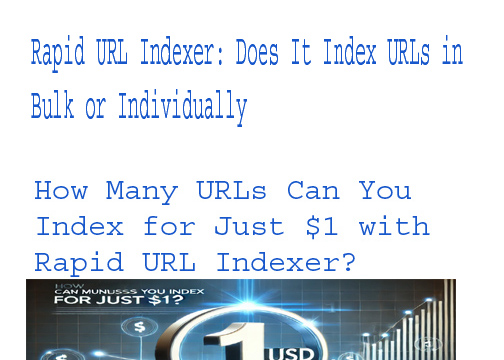Efficient indexing is crucial for SEO success, especially when it comes to handling multiple URLs. Whether you're trying to index web pages, blog posts, or backlinks, rapid indexing tools like Rapid URL Indexer can make a significant difference in getting your content seen faster by search engines. But how does Rapid URL Indexer work when it comes to handling multiple URLs? Can it index them all at once, or does it work one by one?
In this article, we'll explore how Rapid URL Indexer handles multiple URLs, the indexing policy it follows, and how you can use it to optimize your SEO efforts, particularly when it comes to backlink indexing.
Does Rapid URL Indexer Handle Multiple URLs at Once or One by One?
Bulk Indexing
One of the major benefits of Rapid URL Indexer is that it can handle multiple URLs at once. When you’re working on large SEO campaigns, particularly when building backlinks, you might need to index dozens or even hundreds of URLs simultaneously. Bulk indexing allows you to submit all these URLs in one go, saving you valuable time. With bulk submission, the tool sends multiple URLs to indexing services in a single request, which is highly efficient when managing large-scale SEO tasks.One-by-One Indexing
While bulk indexing is an option, Rapid URL Indexer can also handle one-by-one submissions. This is ideal when you want more granular control over the indexing process, such as when you need to prioritize certain URLs or monitor the indexing status of individual pages. By submitting URLs one by one, you can track progress more easily and ensure that each URL is properly indexed.Indexing Policies for Multiple URLs
Rapid Indexing
Rapid URL Indexer’s indexing policy ensures that URLs are indexed as quickly as possible. Whether you’re submitting one URL or hundreds, the tool’s objective is to get them all into search engine databases efficiently.- Batch submission: Multiple URLs can be submitted at once, reducing manual work and speeding up the indexing process.
- API limits: Some search engines, like Google, may have API limits on how many URLs can be indexed at once, but the tool manages these limits to ensure all URLs are eventually indexed.
Frequency of Submission
Rapid URL Indexer also considers the frequency of submissions. Submitting too many URLs at once might trigger spam filters on some search engines, so the tool balances submission rates to avoid penalties while maximizing indexing speed.How to Use Rapid URL Indexer Plugin on a WP Website
Using the Rapid URL Indexer plugin on your WordPress website is straightforward. Follow these steps:- Install the Plugin Download and install the Rapid URL Indexer plugin from the WordPress plugin repository or directly from the developer’s website.
- API Key Setup After installation, you'll need to link the plugin to your Rapid URL Indexer account by entering the API key. You can obtain your API key from your account on Rapid URL Indexer’s website.
- Submit URLs for Indexing Once connected, you can submit individual URLs or multiple URLs directly from the WordPress dashboard. Simply paste the URLs into the submission box, and the plugin will take care of the rest by sending them to the Rapid URL Indexer API.
- Track Indexing Status The plugin will provide feedback on the indexing status of your URLs, so you can monitor which pages or backlinks have been successfully indexed.
Best Practices for Using the Plugin
While the Rapid URL Indexer plugin is a powerful tool, there are some best practices to follow to ensure you're using it effectively:- Don’t Overload the System Submitting too many URLs at once might trigger search engine spam filters. Stick to a reasonable number of URLs per submission, especially for new websites with little authority.
- Prioritize Important Pages Submit your most critical URLs first, such as main landing pages, blog posts, or backlinks from high-authority sites. These will give you the most significant SEO benefits.
- Monitor the Indexing Status Use the plugin’s feedback system to monitor which URLs have been successfully indexed. If a URL isn’t indexed after submission, you can investigate the reasons and resubmit if necessary.
- Stay Updated Keep the plugin and your WordPress installation up to date to ensure optimal performance and compatibility with the latest WordPress and Rapid URL Indexer API updates.
